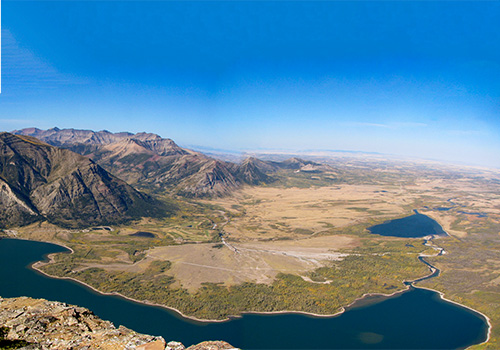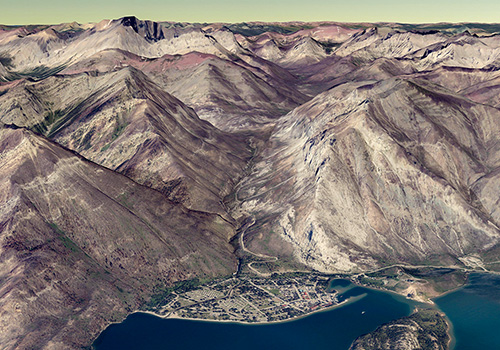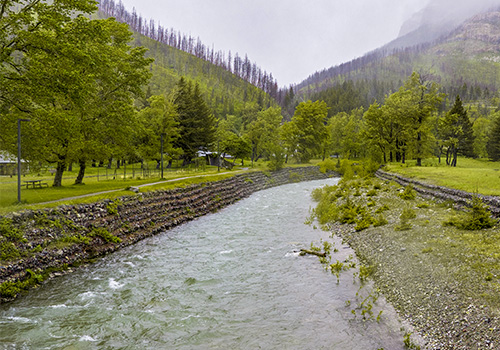
Floods: A tale of two fans
Waterton Lakes National Park
 Blakiston Fan
Blakiston FanAllow us to take you back a few thousand years. Picture glacial meltwaters in full swing, carrying enormous quantities of eroded mountain material down what are now Cameron and Blakiston creeks. These deposited into Waterton Lake, creating fan-shaped landforms known as alluvial fans, notably the Blakiston and townsite fans.
The Blakiston Fan, created and maintained by Blakiston Creek, is the largest alluvial fan in Waterton Lakes National Park and important wildlife habitat. Blakiston Creek bisects what was once one large lake into what are now known as the Lower and Middle Waterton Lakes. In spring, an amazing variety of wildflowers carpet the ground. Nutrient-rich fescue grasses provide a key winter food source for ungulates, particularly elk and mule deer.
Thanks to Waterton’s windy winters, these animals can happily graze snow-free and escape to the surrounding aspen groves for shelter when the wind escalates. The Blakiston Fan is also home to many birds, bears, deer and coyotes. Nature certainly rules this wild and scenic location.
 Townsite Alluvial Fan
Townsite Alluvial FanThe Townsite Fan was formed at the base of Cameron Falls. Today, this fan is dominated by cultivated lawns and garden plants, but it was originally covered with native fescue grasses and aspen groves, much like the present-day Blakiston Fan. Despite this, the Townsite continues to provide vital wildlife habitat for deer, bighorn sheep, ground squirrels and birds. Predators such as cougars or coyotes are rare here, and are generally only seen when passing through.
Alluvial fans are maintained by floodwaters that spread freshly eroded mountain sediment across the fan's surface. These floodwaters rearrange existing rocks and soil and redirect stream channels. Remnants of past floods can be seen in the dry, abandoned stream channels still visible on the Blakiston Fan’s surface.
 Cameron Creek contained by rock and wire.
Cameron Creek contained by rock and wire.While flooding is a natural process, Parks Canada takes steps to prevent infrastructure damage from larger floods. For example, Cameron Creek’s banks have been supported by gabion walls (wire baskets of rocks) in places, and the creek is occasionally dredged as well. While this creates a deeper channel for water and mitigates flooding risk for homes, it also ultimately affects the natural process that maintains the fan.
The 2022 Management Plan identifies that that the absence of key natural processes is detrimental to the integrity of the fescue grasslands ecosystem. Parks Canada staff strive to avoid manipulating natural processes and to keep disturbance of landforms to a minimum. In the townsite, some management of natural processes is needed. Out on the Blakiston Fan, the challenge is for us to allow nature to unfold as much as possible.
- Date modified :